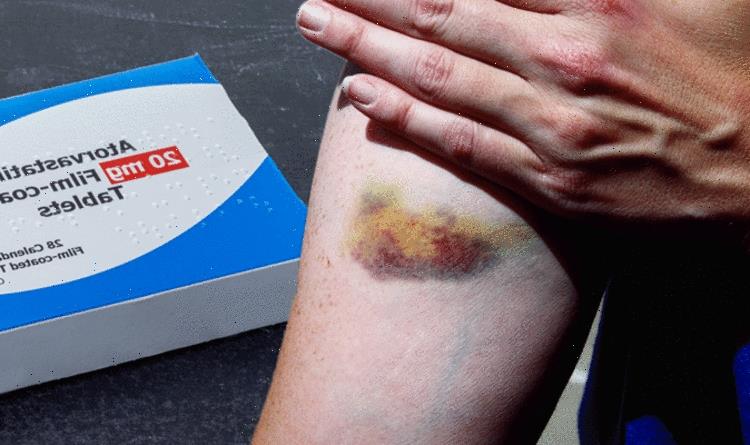Statins side effects: Drug can cause thrombocytopenia warns the NHS – signs on your body
Statins: How the drug prevents heart attacks and strokes
We use your sign-up to provide content in ways you’ve consented to and to improve our understanding of you. This may include adverts from us and 3rd parties based on our understanding. You can unsubscribe at any time. More info
Statins are a group of medicines that can help lower the level of low-density lipoprotein (LDL) cholesterol in the blood. LDL cholesterol clings to the inside of your blood vessels, thereby raising your risk of serious heart problems. Statins reduce the production of LDL cholesterol inside the liver.
The benefits of taking statins outweigh the risks for most people but the cholesterol drug can cause side effects.
According to the NHS, statins can cause low blood platelet count, also known as thrombocytopenia.
Platelets (thrombocytes) are colorless blood cells that help blood clot. Platelets stop bleeding by clumping and forming plugs in blood vessel injuries.
Thrombocytopenia can be mild and cause few signs or symptoms.

According to the Mayo Clinic, thrombocytopenia signs and symptoms may include:
- Easy or excessive bruising (purpura)
- Superficial bleeding into the skin that appears as a rash of pinpoint-sized reddish-purple spots (petechiae), usually on the lower legs
- Prolonged bleeding from cuts
- Bleeding from your gums or nose
- Blood in urine or stools
- Unusually heavy menstrual flows
- Fatigue
- Enlarged spleen.
How common is it?
Research suggests drug-induced thrombocytopenia is rarely associated with statin medications.
A case study published in the journal Cureus suggests it is associated with atorvastatin – a commonly prescribed type of statin.
It describes the case of a 69-year-old woman who developed thrombocytopenia following atorvastatin use.
DON’T MISS
Susanna Reid health: ‘There is no cure’ – presenter’s battle with ‘bad’ condition [INSIGHT]
Dementia: ‘Commonly prescribed’ drug linked to increased risk [ADVICE]
Supplements: Popular pill shown to increase cancer risk [TIPS]
“To our knowledge, this is the fourth reported case of atorvastatin-induced thrombocytopenia,” wrote the researchers.
A 69-year-old female with a history of hyperlipidemia (high cholesterol) presented to the hospital with atraumatic bruising, traumatic right knee hematoma, and multiple painless “blood blisters” which she noticed one day prior.
Her history was negative for bleeding disorders, anticoagulant use, and antiplatelet use. She started taking atorvastatin 20 mg daily about 10 weeks before presenting for hyperlipidemia.
The patient was found to have profound thrombocytopenia on admission to hospital. It was determined that atorvastatin use was behind the thrombocytopenia.

Other side effects include:
- Headache
- Dizziness
- Feeling sick
- Feeling unusually tired or physically weak
- Digestive system problems, such as constipation, diarrhoea, indigestion or farting
- Muscle pain
- Sleep problems.
What the NHS says
“You should discuss the benefits and risks of taking statins with your doctor before you start taking the medicine.”
The health body continues: “If you find certain side effects particularly troublesome, talk to the doctor in charge of your care. Your dose may need to be adjusted or you may need a different type of statin.”
Many people who take statins experience no or very few side effects.

The risks of any side effects also have to be balanced against the benefits of preventing serious problems.
A review of scientific studies into the effectiveness of statins found around one in every 50 people who take the medicine for five years will avoid a serious event, such as a heart attack or stroke, as a result.
You can also lower high cholesterol levels naturally.
Lifestyle changes that can reduce your cholesterol level include:
- Eating a healthy, balanced diet
- Exercising regularly
- Maintaining a healthy weight
- Limiting the amount of alcohol you drink
- Stopping smoking.
Source: Read Full Article
